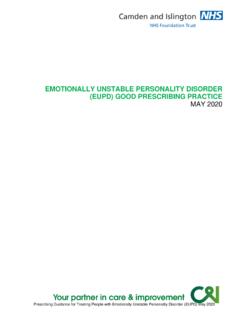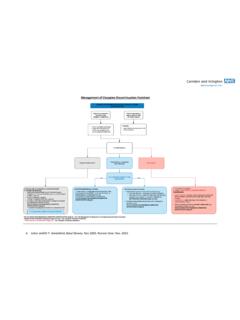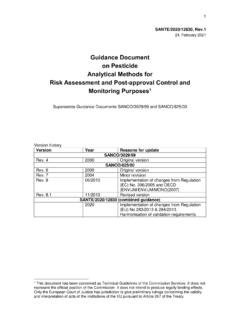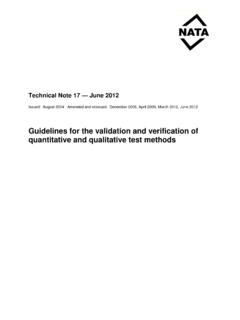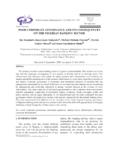Transcription of Infection Prevention and Control Policies and Procedures
1 Infection Prevention and Control Policies and Procedures January 2018. 1|P a g e Table of Contents Section Policy/ Procedures content Page Introduction Introduction 5. Roles and Responsibilities 6. Scope 8. Purpose 8. Monitoring/Audit 8. Explanation of terms used 8. Appendix 1: Infection Control Team Contact Details 15. Appendix 2: Infection Control in Mental Health Poster 16. Section A: Central Principles of Infection Control A1 Hand Hygiene 18. Appendix 1: Hand hygiene guidance at a glance 24. A2 Standard Infection Control Precautions 25. Appendix 1:Point of Care Risk assessment 31. Appendix 2:Donning and doffing PPE 32. Appendix 3: Glove Use Matrix 33. Appendix 4: Standard Precautions Poster 34. A3 Transmission-based Precautions (TBP) 35. Appendix 1:TBP for communicable diseases 42.
2 Appendix 2: Priority Matrix for side room occupancy 49. Appendix 3: Contact precautions guide 50. Appendix 4: Droplet precautions guide 51. Appendix 5: Airborne precautions guide 52. Appendix 6: Respiratory hygiene guide 53. A4 Outbreak management-viral gastroenteritis 54. Appendix 1:Outbreak Control Measures 56. Appendix 2: What to do in the event of two or more cases 57. of D+V in your clinical area Appendix 3: management of service users with D+V in 58. day centres Appendix 4: How to assess diarrhoea and vomiting 59. Appendix 5:Outbreak ward signage 61. Appendix 6: Daily checklist for use in GI outbreak 62. Appendix 7: Outbreak Monitoring Forms 64. A5 Surveillance for healthcare associated Infection (HAI) 66. and communicable diseases A6 Aseptic Technique 68. A7 Immunisation of service users and handling/storage 70.
3 Of vaccines A8 Infection Control guidance for new builds, 73. refurbishments, and renovations Appendix 1:Construction risk matrix 81. A9 Working/domestic dogs guidance 83. A10 Care of the Deceased 85. Section B: Environmental Hygiene/Safety B1 Decontamination 88. Appendix 1: Commonly used equipment and how to 94. decontaminate it Appendix 2:How to use Clinell Universal wipes 98. Appendix 3: Infection risks and categories 99. Appendix 4: National colour-coding scheme for hospital 100. 2|P a g e cleaning materials and equipment Appendix 5:Handling of equipment prior to repair 101. Appendix 6: Certificate of decontamination 102. B2 Management of blood and body fluid spillages 103. Appendix 1: Blood and body fluid spillages guidance at a 105. glance B3 Linen 106. B4 Safe use and disposal of sharps 109.
4 Appendix 1: Sharps safety guidance at a glance 111. Appendix 2: What to do in the event of a sharps injury 112. B5 Waste Management 113. Appendix 1: making waste segregation simple 114. B6 Specimen handling and transportation 115. Appendix 1: Specimen handling guidance at a glance 117. Section C: Common and important infectious diseases and their management C1 MRSA 119. Appendix 1:MRSA Screening 121. Appendix 2: MRSA Treatment protocol 122. C2 Carbapenemase-producing Enterobacteriaceae 123. (CPE). C3 Tuberculosis 125. C4 Ectoparasites 128. C5 Blood-borne Viruses 134. C6 Viral Haemorrhagic Fevers 136. C7 Herpes Varicella/Zoster Virus (Chickenpox/Shingles) 140. C8 Food poisoning 142. Appendix 1: Food hygiene guidance at a glance 147. C9 Legionnaires' Disease 148. Appendix 1:Register of underused outlets and flushing 150.
5 Schedule C10 Antibiotic-associated diarrhoea (c. difficile) 151. C11 Variant Creutzfeldt-Jakob disease (vCJD) 153. C12 Rubella 156. Section D: References D References/Evidence based 158. EIA Equality Impact Assessment 170. 3|P a g e Infection Prevention and Control Policy and Procedures Policy title Policy reference CL05. Policy category Clinical Relevant to All staff involved in the direct and in-direct care of service users. Date published January 2018. Implementation January 2018. date Date last January 2018. reviewed Next review June 2018. date Policy lead Lead Infection Control Nurse Contact details Accountable Director of Nursing and Quality director Approved by Infection Control Committee (Group): Approved by Quality Committee (Committee): Document Date Version Summary of amendments history Feb 2005 1 New June 2008 2 Review May 2011 3 Review Dec 2015 4 Comprehensive review Amendments to single use medical products (PAN11), contacts update and change of Jan 2018 Occupational Health information (new provider).
6 Membership of the policy development/ Infection Control and Prevention Team and Clinical and Corporate Policy manager review team Consultation Infection Control Champions DO NOT AMEND THIS DOCUMENT. Further copies of this document can be found on the Foundation Trust intranet. 4|P a g e Introduction The Policies and Procedures set out in this manual are based on national and international published best practices. As new information becomes available, this document will be reviewed and updated. Infection Prevention and Control strategies are designed to protect service users and healthcare staff from the risk of transmissible disease. A systematic approach to Infection Prevention and Control requires each health care provider to play a vital role in protecting everyone who utilizes the healthcare system.
7 Healthcare staff must adhere to Infection Prevention and Control guidelines and Policies at all times, and use critical thinking, risk assessment and problem solving in managing clinical situations The Health and Social Care Act 2008: Code of Practice (2015). The Health and Social Care Act 2008: Code of Practice for the NHS on the Prevention and Control of Healthcare Associated Infections and Related Guidance requires that each NHS. body has systems in place that are sufficient to minimise the risk of infections to patients, staff and visitors. The Healthcare Commission monitors performance against the Code of Practice as part of the annual health-check and compliance with Standards for Better Health. The Infection Control Service ensures that systems are in place to achieve this-for example by having an annual programme of work.
8 The Code requires that an NHS body must, in relation to preventing and controlling the risks of HCAIs, have in place the appropriate core Policies . These core Policies can be found within relevant sections of the Infection Prevention and Control Policy Manual. Other trust Policies to which this policy relates Cleaning services Building and refurbishment, including air-handling systems Waste management Laundry arrangements for used and infected linen Planned preventive maintenance Pest Control Management of drinkable and non-drinkable water supplies Minimising the risk of Legionella by adhering to national guidance; and monitoring Food services, including food hygiene and food brought into the care setting by service users, staff and visitors Roles and Responsibilities The Chief Executive The Chief Executive is responsible for ensuring that there are effective arrangements for Infection Control within the Trust.
9 These arrangements include the provision of an Infection Control Team and an Infection Control Group that is supported by a Director of Infection Prevention and Control . Also to ensure that there is an annual Infection Control programme/matrix which is supported and approved by the Trust Board. 5|P a g e The Camden and Islington NHS Foundation Trust Board and ultimately the Chief Executive carry responsibility for Infection Prevention and Control throughout the Foundation Trust The Director of Infection Prevention and Control (DIPC). The Director of Infection Prevention and Control (DIPC) will support the Infection Control Team and the Infection Control Committee in their fulfilment of its Infection Control Plan and will: Oversee the local Infection Prevention and Control Policies and their implementation.
10 Have the authority to challenge inappropriate clinical hygiene practice as well as antibiotic prescribing decisions. Take steps to ensure that staff adheres to the Infection Prevention and Control Policy Manual. Chair the Infection Control Committee Report directly to the Chief Executive and the Trust Board. Present the Annual Infection Prevention and Control Report to the Trust Board. The Infection Control Committee (ICC). The purpose of the Infection Control Committee is to direct the Trust's response to infections and to ensure that the relevant elements of national Policies and guidance are addressed. The committee will ensure that the standards of Infection Control assure the public to have confidence in the Trusts' commitment to safely manage the agenda. The Infection Control Committee is a sub-committee of the Clinical Governance Committee and will submit its minutes to that committee via the DIPC.

